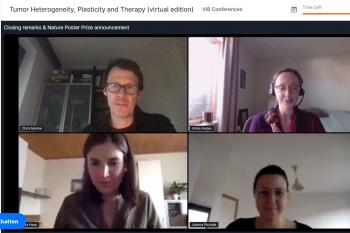The first (virtual) edition of VIB’s Tumor Heterogeneity, Plasticity and Therapy conference:
A year ago, the first edition of the Tumor Heterogeneity, Plasticity and Therapy conference, was planned in Leuven. As the global pandemic intervened, the conference was postponed to 2021 and switched to a virtual format. While a completely online conference comes with its challenges, this first edition was definitely a success. The impressive line-up of speakers and the diverse program attracted 420 attendees, who contributed to the interactive atmosphere together with speakers, sponsors and organizers.
Hot topics discussed
Charles Swanton provided compelling evidence that genetic events drive cancer evolution, highlighting in particular the role of genome doubling in this process. Other invited speakers described the contribution of non-genetic factors in tumorigenesis, metastasis and resistance to targeted and immune-therapies. Mark Dawson delved elegantly into the role of enhancers reprogramming as a driving force in the resistance of AML to therapy.
VIB's own Sarah-Maria Fendt was one of the speakers who highlighted the importance of metabolic adaptation. She described how the dynamics and reversible expression of a key metabolic enzyme is essential for metastatic dissemination. Caroline Dive went even further into phenotypic cell reprogramming events, as she demonstrated how tumor cells can trans-differentiate into vascular-like structures through vasculogenic mimicry. Michelle Monje in her talk highlighted the extraordinary ability of glioma to produce electrically active tissue.
More than reprogramming of tumor cells themselves, the role of tumor microenvironment was shown to be critical in shaping tumor evolution. In particular, the role of the immune system was at the heart of numerous stories, and further illustrated by the concept of an ‘immunoscore’, which is used to classify human clinical samples and first introduced by Jerome Galon, one of the invited speakers.
Cutting-edge technologies discussed by leading scientists
This conference also highlighted the importance of applying (and further developing ) cutting-edge technologies to tackle the many remaining burning questions in the field. Barcoding technologies (Anna Obenauf, Mark Dawson), optogenetics (Michelle Monje), lineage tracing, intra-vital imaging or single-cell multi-omics techniques are being used and offering powerful methods to dissect the mechanisms underlying intra-tumor heterogeneity (Itay Tirosh, etc) and therapy resistance (Diether Lambrechts, …). Moreover, model systems are also evolving to better reflect the patient reality! Karuna Ganesh, for instance, showed how patients-derived organoids faithfully recapitulate what happens in people.
Thanks to these advances the field is moving very fast and the role of cell plasticity and the challenges that it poses for diagnostics and therapy resistance, as beautifully illustrated by Fred de Sauvage, are now being fully considered and investigated. How do we integrate the nongenetic and genetic driving forces of tumor evolution in a united and conceptual framework? How does the micro-environment and the macro-environment remodel the tumor ecosystem in space and time? Next years of research in the field hopefully promise breakthrough findings that will shed light on these exciting and remaining questions!
The people make the conference
A (virtual) conference is not only about science. The amazing science was balanced by the social side of the conference. Over 100 posters were presented and discussed during the 2 poster sessions. These posters contained novel observations and cutting-edge technologies in the fields of heterogeneity, plasticity, immunotherapy or targeted therapy. All were presented with great enthusiasm, and the two best posters were awarded with the Nature poster prize. Burning questions were asked during the meet-the-speaker sessions, new opportunities discussed in (company) booths. The virtual coffee breaks and networking sessions were the ideal moment to chat with colleagues or collaborators from all over the globe without the need for commuting. The time differences were faced with a smile and a joke, a morning coffee or an evening-drink at hand.
The best is yet to come
This virtual edition of THPT21 will stick in our head for a number of reasons. The fascinating science planted seeds for future projects and collaborations. The inspiring new technologies triggered our enthusiasm for more in-depth research. While technology offers attractive alternatives to make a virtual edition worthwhile, we reminisce the magic of live, scientific discussions. Let us all mark our agendas for the next, live edition of Tumor Heterogeneity, Plasticity and Therapy in May 2023. In the meantime, we look forward to the application of all this knowledge for solving essential questions in clinic and society. See you soon!
See the conference hashtag on twitter for more impressions of the event.
